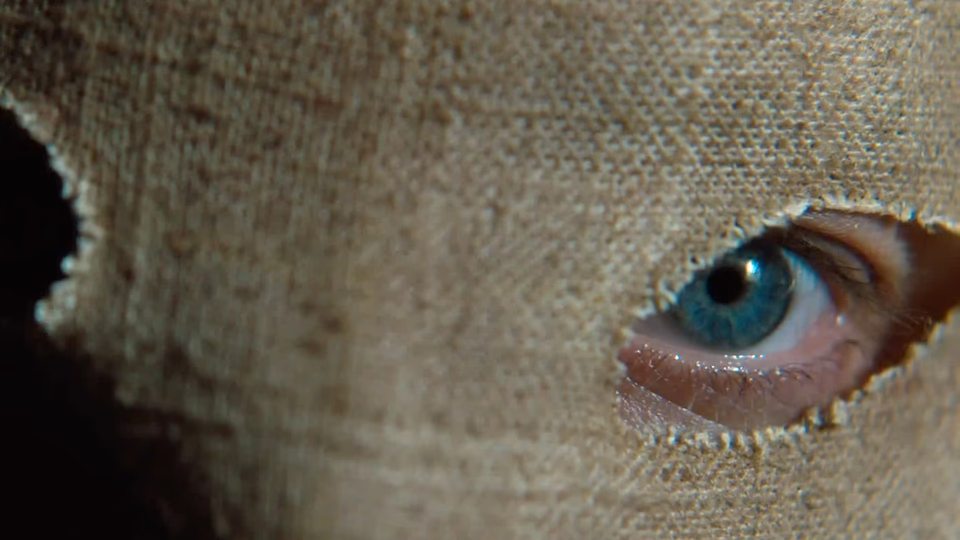The Town That Dreaded Sundown

The Town That Dreaded Sundown starts with a prologue recounting a series of unsolved murders that occurred in Texarkana in 1946. It talks about how those killings formed the basis for the original film, which screens every Halloween somewhere in Texarkana.
The film opens on one of those screenings. It’s a drive-in. The camera pans down to a teen couple sitting on the hood of a car. He seems into the film, but she looks uneasy. She says it’s not her kind of movie. He asks her if she wants to go. She does, and they head out. As they leave, the camera picks up a preacher imploring the patrons to remember that people really died back in 1946.
The couple head out for a quiet, deserted area where they can be alone. He makes small talk as they drive. The camera shows them at a tilted angle. It’s an on-the-nose gimmick that foreshadows one of the film’s biggest weaknesses.
Soon they’re parked. They start kissing, but the girl spots a man in the nearby woods. He’s dressed just like the killer from the movie. But this is no prank. The man breaks the car’s window with the butt of a revolver. He orders them out of the car at gunpoint, then forces the girl to turn around while he stabs the boy to death.
And we’re off and running. By genre definitions, the film is a slasher, but I’m always hesitant to use that term. For many people, that equates to the Friday the 13th and Halloween series of films, which were, for the most part, more monster and survival-horror films than slasher. The Town That Dreaded Sundown is more of a violent mystery. Victims are stalked and murdered in a brutal but stylish manner and we work along with the protagonist to deduce the killer’s identity from a number of suspects. To that end, The Town That Dreaded Sundown may be the first rural giallo.
There’s a lot to like. The supporting cast includes Edward Herrmann as the aforementioned preacher, and Gary Cole as a sheriff’s deputy.
The script’s meta-sequel approach works well. It avoids the trap of aggrandizing the original film by regulating it to well-researched pulp entertainment. Granted, this film does play as something of a remake, but by excising the original’s head-scratching bits of comic relief, this entry crafts a much taunter narrative.
But the film is far from perfect. Remember the gimmick shot I mentioned earlier? The movie is full of them. Some of them work, but their impact is lost in the shuffle.
Consider the scene, set at night, where a woman flees the killer into a huge wheat field. The killer has a gun. He fires and she drops to the ground amid the wheat. He approaches, but can’t find the body. Cut to a bird’s eye shot of the field and we see the woman crawling away from the killer as he stalks forward. They’re not more than six feet apart, but they can’t see each other. The shot’s only held for a few moments before we cut back to a tight shot of the killer.
Why? That was a great shot. Keep it. Cut the music. Just give us the sound of the wind and let us watch from above as she crawls, hoping against hope that he doesn’t see her. Their meeting is inevitable, but the tension would have been palpable watching the two skew towards one another.
And then there’s the ending.
But before we get to that, let me say that I liked the movie. The location photography, colorful supporting cast, and competent script make for a solid little slasher. So, having said that, and having given you a sense of what the film is about and what it’s like, I feel my job as reviewer is done. If you want to stop reading here, I’ll understand.
Still with me? Okay. I didn’t love the ending. I didn’t hate it either. It felt like a missed opportunity.
Here’s why. The script touches on the notion of violence inspired by the media several times, but only in passing. I felt the film was building to something however, and when the heroine makes to leave town with her grandmother, it struck me. What if this is the end of the movie? She leaves and the killer is never caught. The end. All the bits about inspired violence coalesce into a biting commentary. The killer will be there as long as he has an audience. It would even dovetail nicely with the original’s ambiguous ending.
Sure, some folks would hate it, but I bet a lot of theater-goers hated the original’s ending too. And yet, that ending helped the original resonate enough to inspire a remake almost forty years later.